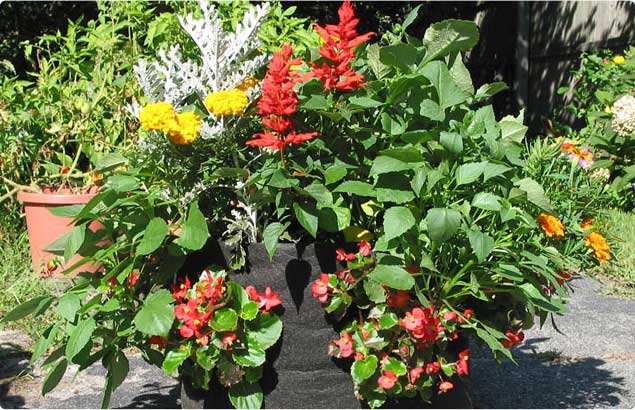Getting “Bac” to Basics: Four Tips for Cultivating Soil Bacteria and Garden Microbes
4 Tips for Cultivating Soil Bacteria and Garden Microbes
Plants and microbes have evolved together for hundreds of millions of years. Their connection is a basic building block for earth’s terrestrial ecosystems. Today, scientists recognize microorganisms as key contributors to plant growth and health. In the garden, all those invisible microbes can make or break your growing season. Today, we’ll look at four ways you can promote a healthy ecosystem at the microscopic level.
Be a fun-guy. Use mycorrhizal inoculant.
Mycorrhiza are tiny fungal filaments (known as “mycelia”) that weave themselves throughout a plant’s roots. Technically, fungi don’t have roots, but mycorrhiza are structurally and functionally similar.
These tiny fungal fibers wrap around roots, helping them extract water and nutrients from the soil. They also protect roots from predators, and in return receive plentiful carbohydrates from the plant. It’s a marriage made in heaven, and you can use it to your advantage.
Mycorrhizal inoculant is available from numerous online sources and probably at your local lawn and garden store. Look for Rhizophagus irregularis. It’s a popular variety and works well with most domesticated plants. To apply it, rub the powder on the root ball or sprinkle it in the hole. You can also mix it directly with seeds before planting. If you want to grow beneficial garden microbes, placing them directly into the soil is a good start.
Mulch it Up
Adding a layer of mulch can work wonders for garden microbes, especially if you use compost. Mulch repels the sun’s rays, cooling the soil on hot days. It also acts as a moisture barrier, trapping humidity below the surface during summer months.
Compost is an especially effective mulch because it leaches beneficial nutrients into the soil. It’s also teeming with (you guessed it!) beneficial plant microbes. In fact, compost contains a diverse array of plant bacteria not found in commercial inoculants. If you want to colonize your garden with soil bacteria, start by spreading a thick layer of “black gold.”
Whip Up Your Own Probiotics
It’s entirely possible to brew your own garden microbes using a few simple materials. All you need is a jar, some molasses, a little water and some dirt. Homebrewed microbial mix can be spray directly onto plant foliage or diluted in water to increase its volume. Remember, the idea is to colonize the garden with healthy, biodiverse soil bacteria. Translation: More isn’t always better. If you’ve always wanted to try home brewing, start with a cocktail — of thriving plant microbes!
Open a Can of Worms
If compost is black gold, worm castings are black platinum. They’re plentiful in nitrogen, phosphorus, potassium and numerous micronutrients. They are also bursting with a vast array of garden microbes. Want to get access to an endless supply? Build your own wormery.
Begin by purchasing an opaque plastic box. A typical closet organizer will do the trick. Next, drill 20 to 30 holes in the bottom to promote healthy air flow. You’ll also want air holes around the top and sides to allow oxygen to flow in. Layer the bottom with several sheets of newspaper, and cover it with 3-4 inches of moist compost. Finally, add some worms. Red wigglers are a great choice and can be purchased inexpensively. Depending on the size of your bin, 300-500 worms is a good start.
Keep your worms healthy with a diet of vegetable scraps and peelings. Meat, bones, grease and eggshells are a no-no. Monitor the moisture levels in your soil, adding water when you no longer see condensation on the inside of the lid. Oh, and about the lid… You’ll want to keep it on to retain moisture and block sunlight. Keep the box out of direct sun, so you don’t cook the poor buggers. Within several weeks, you’ll have a rich and inexhaustible supply of black platinum. (Black platinum. You heard it here first.)
Step Up to the Culture Plate
Colonizing your garden with beneficial microbes may sound like a fancy, complicated, scientific endeavor. In reality, it’s a simple and sensible way to boost plant health and productivity. Whether you’re a novice or a master gardener, put soil bacteria to work for you. Plants have been doing it for millions of years. Who knows? Maybe they’re onto something.







Hi,
Thanks for the information, I’m renting and never had a garden before. The place I’m in now has thick black mulch at the top and clay below, no soil. The plants aren’t doing well (weeds and grass are doing fine because they are the invasive types and it’s wet here often), it seems the lack of soil has killed any microorganisms. I don’t have a car so I can’t drive down to the local garden store to get potting mix, this will help me create some soil. Thanks ????????????????
Hi mix soil with fertilizer. Mix the loose on top 50/50 with the clay. You really need to get Chicken or cow fertilizer to start in spring 33/33/33 dig 12-18 inches is best. if you can get help to get that even 1x per season . then add other fertilizers with microbes if you can afford . But at least do your NPK more n for leaf stem root then more pk later for flower fruiting. toss in a hole small amount of very small chopped leftover veggies no pitted fruits . Then order Jim’s worms online. Make sure no flesh dairy oils in foods and put away from plant roots but near plants under loose thin cover of soil . worms will eat and make threat compost . There’s a lot to learn but this should get things started .
Great article! How can we specifically utilize fungi like Rhizophagus intraradices to enhance plant growth in our gardens? Any practical tips for incorporating them into our soil? Thanks!